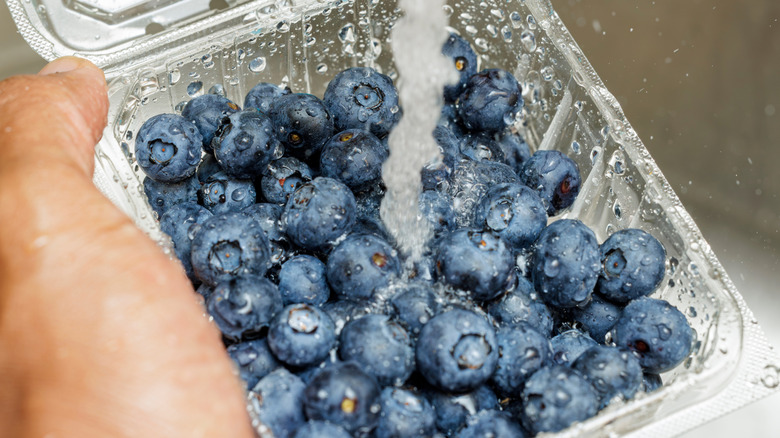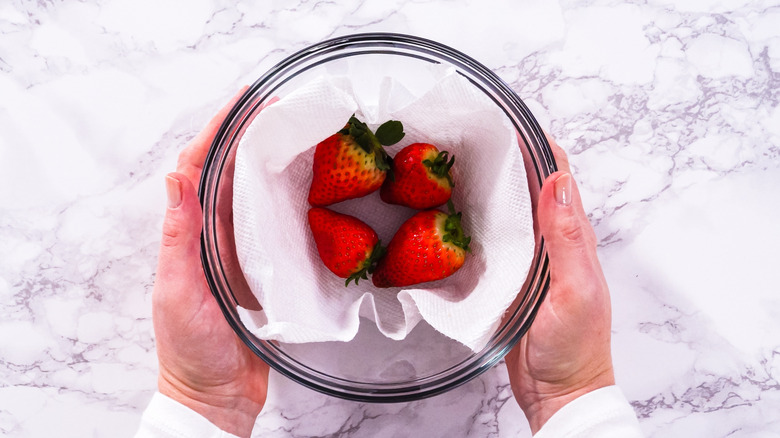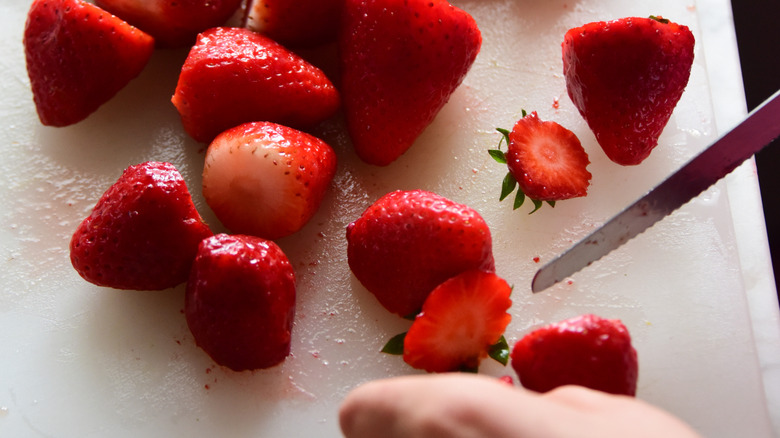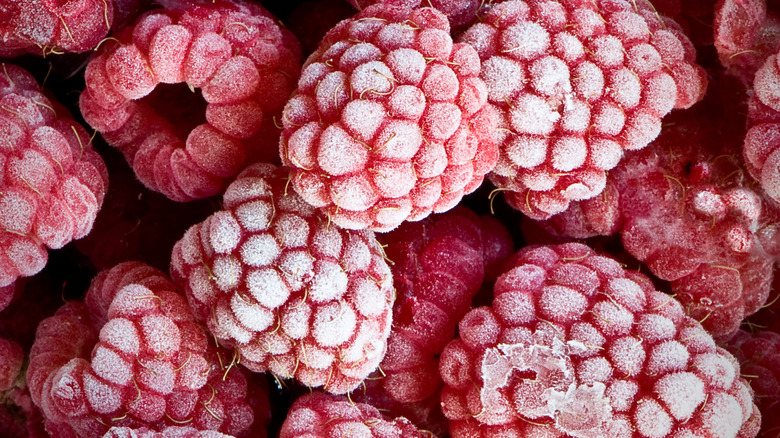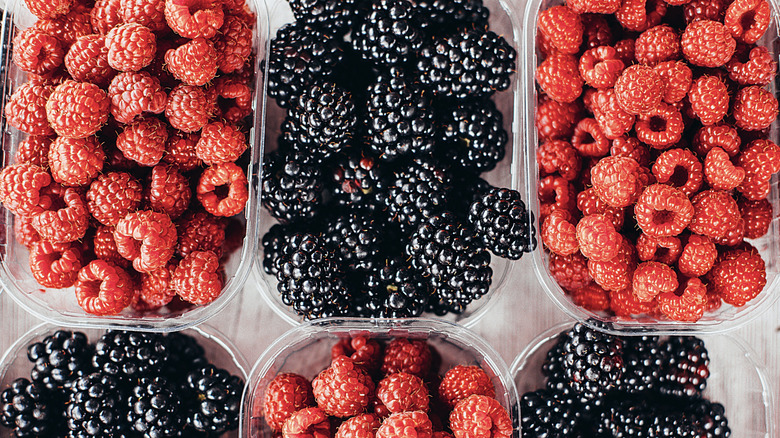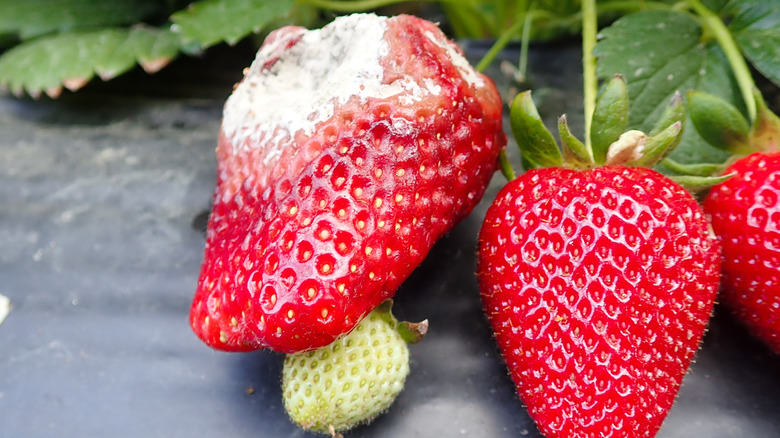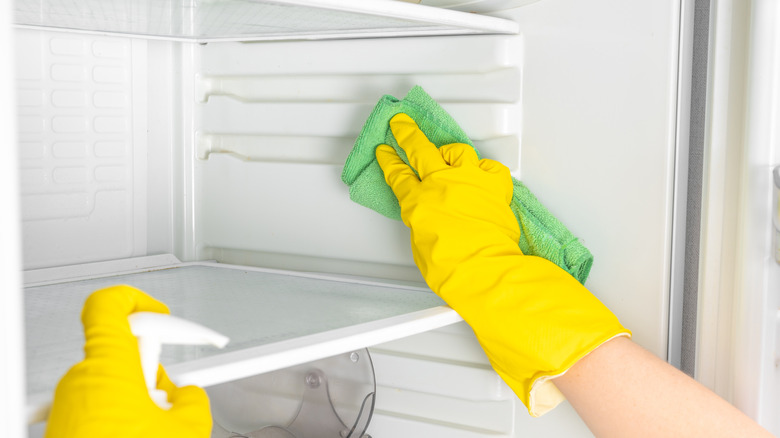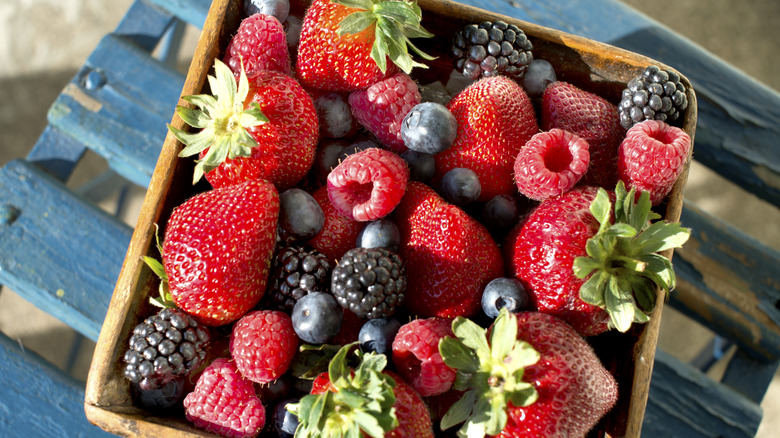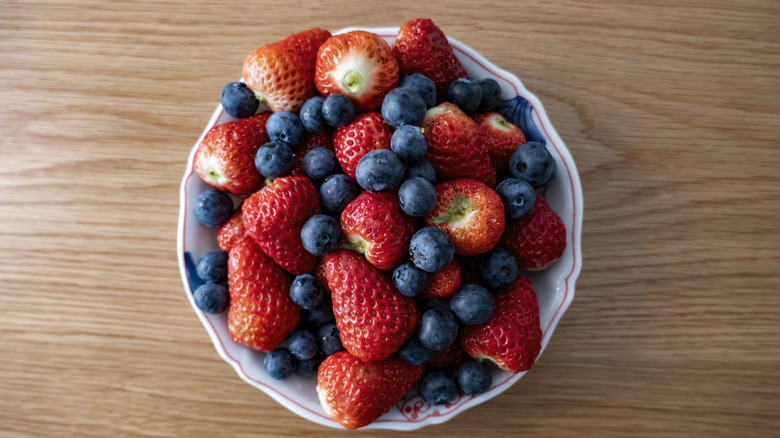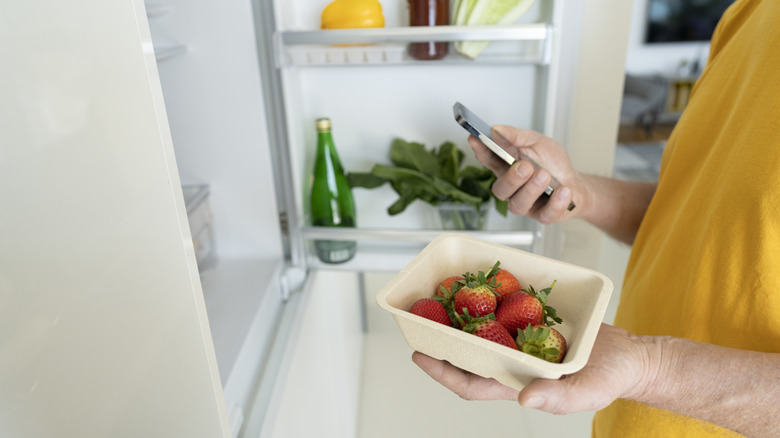10 Storage Mistakes That Are Making Your Berries Moldy
Berries are one of the healthiest foods we can eat. For starters, they are packed with important nutrients, like vitamins and minerals, but on top of this, they also contain potent plant compounds called antioxidants.
As the name suggests, antioxidants help to tackle harmful oxidative damage in our bodies. Over time, this damage can increase the risk of several chronic diseases, including cancer, Alzheimer's, and the leading cause of death globally, heart disease. However, research suggests that eating just three portions of blueberries or strawberries a week, for example, could reduce the risk of heart attacks by as much as 32%. Berries are also an excellent source of fiber, which is essential for gut and digestive health. It is recommended that we all need to get around 50 grams of fiber a day to improve our health and reduce the risk of colon cancer.
But health benefits aside, there is, of course, another important reason to eat berries: they are delicious. They are naturally sweet and juicy, and are perfect for everything from smoothies to waffles to pancakes to dessert pies and galettes. This is why we all want our berries to last as long as possible after we've bought them — so we can enjoy their flavor and reap all of the health benefits they have to offer. Keep reading to find out all the common storage mistakes people make with berries, so you can learn from them and get the most life out of your fruit for as long as possible.
1. Improperly washing berries before putting them in the fridge
If you want your berries to stay juicy and delicious for longer, a good place to start is by keeping them away from moisture. This means that once you've brought them home from the store or the farmers market, you shouldn't rinse them with water before you place them in the fridge — even though it might be tempting to try and clean off any germs. This is because mold thrives in damp, moist conditions, and fruits, like berries, already have a very high water content. A red raspberry, for example, is 85% water, while strawberries are 91% water. Adding more water before you store them will increase the chances of spoilage, which is bad news for your berries (and your food waste footprint).
If you do want to wash your berries before storage, there is another option: vinegar. Because vinegar is very acidic, mold hates it. This is why vinegar is often used as a mold cleaner (in fact, it can kill more than 80% of mold species). Bathe your berries in a mix of vinegar and water before you store them, and the vinegar will help to keep any sneaky spores at bay. Dry them off (thoroughly — remember, moisture is the enemy) and then place them in the fridge, and they should last more than a week. That said, it's best to leave blueberries alone, as this particular berry already has a natural protective coating to keep it fresh.
2. Not storing berries with a paper towel
As we've already highlighted, excess moisture is the last thing you want for your berries (not if you want them to last long enough to enjoy, anyway). As well as drying them thoroughly before you place them in the fridge, there is another handy trick for keeping them as moisture-free as possible, and that's storing them with a paper towel. This is because paper towels are, of course, designed to absorb water – hence why they help us mop up spillages. They will do the same with berries. The towel will absorb the excess water from the fruit, helping to keep the berry fresh for longer.
In one berry storage experiment, The Kitchn stored dry strawberries on a paper towel for a week. It found that by the end of the week, only around 20% of the fruit had gone bad, while the rest of the berries were still fresh enough to eat. This trick doesn't work as well if the berries are wet when they're placed in the fridge. The experiment also discovered that when wet strawberries were placed on a towel, only about 60% of the berries stayed fresh.
Fun fact: Berries aren't the only food that a paper towel can keep fresh in the fridge. Storing bagged salads with a paper towel is also a handy way to stop them from prematurely spoiling. Again, this is because, like berries, salad greens have a lot of water content.
3. Cutting them before storing them
Let's be honest, life is busy. Prepping meals and snacks for the week ahead is often a great way to save time on hectic days when you might not have time to faff around with chopping and slicing. But before you start pre-slicing berries, it's important to consider when in the week you're actually going to eat them. This is because a sliced berry will not stay fresh for very long. In fact, after it has been cut, a berry will likely only last up to a couple of days.
If you do decide to pre-slice your berries, make sure you store them in an airtight container and eat them quickly after slicing. This is because if you cut berries and then leave them out in the fridge, they could begin to grow bacteria pretty quickly. This is because the external protective layer of the fruit has gone, and the inside is exposed to the air, which could lead to a higher chance of pathogen growth.
Usually, berries are a nutritious addition to our diets, but when they're not stored correctly, they can become dangerous. In fact, examples of pathogens that can grow in berries include norovirus (commonly known as the stomach flu) and salmonella, which can lead to a life-threatening illness called salmonellosis. So with all of this in mind, it might be best to leave yourself a few extra minutes to slice your berries right before you eat them.
4. Never freezing them
One of the best ways to make food last longer is to freeze it, and berries are no exception. In fact, you can keep berries in the freezer for at least six months before they start to lose their quality. Sometimes, they will last even longer. Just make sure to keep an eye on them for quality control. Frozen berries are also incredibly versatile — you can use them in everything from tasty smoothies to pancakes to cookies and so much more.
One of the best ways to freeze berries is to wash them, dry them, and place them on a baking sheet with plenty of space between them. Pop this baking sheet in the freezer for a few hours, before switching them to a freezer safe plastic bag or plastic food storage containers and placing them back in the freezer. This way, you won't end up with clumps of berries stuck together when you come to use them in your favorite recipes. If you like to use berries in dessert recipes or baked goods, you can also freeze them with sugar or syrup, which will help to give them a little extra sweetness and help them retain their color and texture, too.
Don't worry, you won't lose all of the health benefits of berries when you freeze them, as all of the nutrients will stay locked inside the fruit. In fact, it may actually help them retain their nutritional value for longer, as they won't degrade as quickly.
5. Storing berries in an airtight container
Plenty of foods need to be kept in an airtight container to reduce spoilage. Rice, for example, thrives in an airtight container, because oxygen causes the grain to degrade faster. Beans, spices, and dried fruits are further examples of foods that need to be kept airtight, either in plastic or glass containers or in a zip-close bag. But berries are not in this club. If you keep your berries in the fridge in your favorite Tupperware, it's likely that you won't have any decent fresh fruit to come back to. Sad, but true.
Again, this is all to do with moisture. Remember: Berries have a very, very high water content. This is great for our bodies, because it means that, on top of being nutritious, berries are very hydrating — eating them regularly even contributes to our daily water intake. But it also means that if they are kept in a container without ventilation, this moisture gets trapped inside. This results in spoiled, moldy fruit, and means we can't enjoy any of the health benefits of berries at all.
Instead, it's best to find a container with holes in it to allow the moisture to evaporate. You can even buy specialized berry storage for your fridge. Some designs come complete with a removable insert to allow the air to flow, while others have holes in the bottom (similar to the wooden berry basket they are in on the store shelves).
6. Leaving moldy berries in with the others
You'll know when one of your berries isn't going to make it. It'll look a little white and fluffy, kind of like cotton wool. But don't be fooled, this fuzzy coating is far from harmless. It is, of course, mold, and if you eat it, you might feel sick. This is why it's best to get rid of the moldy berry before it contaminates the others.
Throwing out one or two berries is always better than having to throw out a whole batch, so as soon as you see one start to look a little fuzzy, it's important to act quickly and get rid of it. Once there is mold in the batch, it can spread fast to the other berries. Its tiny spores (which are hard to see with the naked eye) float through the air, landing on food and contaminating it. If your berries are all packed tightly together, the spores don't need to travel too far to spoil the other fruit.
However, if the mold has already spread to more than a quarter of the berries, it's likely best to cut your losses and get rid of all of the berries. The others may not be visibly moldy yet, but it's likely that they are starting to spoil, too. Mold isn't the only sign that a berry has gone bad. You should also keep an eye out for things like discoloration, foul smells, and a sticky, slimy texture.
7. Not keeping your fridge clean from mold spores
As mentioned above, mold spores travel around easily, moving through the air and landing on surfaces and foods. This means that if there is anything moldy in your fridge, it's likely putting the rest of its contents, including berries, at risk of early spoilage (so let this be your sign to finally get rid of that moldy yogurt or bowl of leftovers hiding at the back of the refrigerator).
Keeping your fridge clean of mold won't just keep your berries fresher for longer and reduce food waste, but it will also benefit your health, too. Exposure to mold can trigger many different symptoms, including congestion, wheezing, and coughing, especially in people who suffer from respiratory conditions like asthma. Mold can also give off mycotoxins, which are poisonous. Aflatoxins, for example, are a known carcinogen. A number of different foods, including berries, are associated with producing aflatoxins. On top of this, fridges can become breeding grounds for bacteria and pathogens if they're not kept clean.
The best way to keep yourself safe and your berries fresh is to clean your fridge regularly. Every couple of months, dissolve baking soda in water and use it to clean the fridge. Baking soda is a natural disinfectant, and it will effectively get rid of any lingering spores. Avoid using bleach (unless there is black mold), as this cleaner is incredibly strong and could transfer onto your food and even affect its taste and odor.
8. Storing mixed berries together
Mixed berries are delicious in many recipes. With their sweet, tangy taste and juicy texture, strawberries, blueberries, raspberries, and blackberries, for example, complement each other well in a range of dishes, like smoothies, pies, compotes, and fruit salads. But when it comes to storage, it's actually best to keep different varieties of berries separate from each other. This is for the simple reason that they each have different shelf lives.
Blackberries, for example, don't survive very long in the fridge. In fact, they usually start to spoil after around three days. After that, they tend to start to spoil, which, of course, affects their quality and their flavor. Blueberries, on the other hand, tend to last much longer. In some cases, they can actually last up to two weeks if they're stored correctly. This is down to the protective coating we mentioned earlier. Called the bloom, this waxy substance helps to protect the berries from predators, like insects, in the natural world. In your fridge, however, it helps keep the berries fresh and ripe for longer.
However, if you were to store blackberries and blueberries together, the former might start to take down the latter with it. Again, this is because mold spores and spoilage can be contagious. So, in short, to get the best out of your favorite berries, make sure to keep them away from each other until you're ready to start prepping your recipe.
9. Keeping them on the counter instead of the fridge
If you've been to the grocery store or farmers market and stocked up on berries that you plan to use the same day, it's usually fine to leave them on the counter for a little while until you're ready to use them. However, if you're not planning to eat your fresh berries anytime soon after you've bought them, it's best to keep them in the fridge. This is because the cold temperatures will help to slow down spoilage and prevent bacterial growth. After all, this is why we have refrigerators: Keeping food cold helps to protect us from germs. As we've established already, it doesn't stop spoilage from happening to your berries, but it does slow it down enough to give us time to eat the fruit before it goes bad.
That said, there are some fruits that can be left out of the fridge. Bananas, for example, are accustomed to hot temperatures (they are, of course, a tropical fruit) and keeping them cold can actually damage them and cause them to spoil more quickly. While we're on the topic of bananas, this particular fruit should be stored away from others (including berries) as the ethylene they give off will cause other fruits to ripen more quickly. Ethylene is a natural, colorless gas that helps plants to grow and ripen.
10. Not keeping them in a low-humidity section of the fridge
By now, we've established that berries are at their best when they're kept in the fridge. However, their placement when they're actually inside the fridge also matters. Fridges often aren't the same from top to bottom. Some crisper drawers, for example, have a humidity dial, which means you can adjust the drawer so it has a lower rate of humidity than the rest of the fridge. This basically means there is less moisture in the air, which is a much better environment for moisture-hating berries.
In general, a low-humidity drawer is the best place for anything that can benefit from losing a little moisture. Other examples of fruits and vegetables that will thrive in the low-humidity section of your fridge include avocados, apples, pears, and mushrooms. High-humidity sections, on the other hand, will benefit vegetables that are prone to wilting. Think: broccoli, cucumber, and leafy greens, for example.

